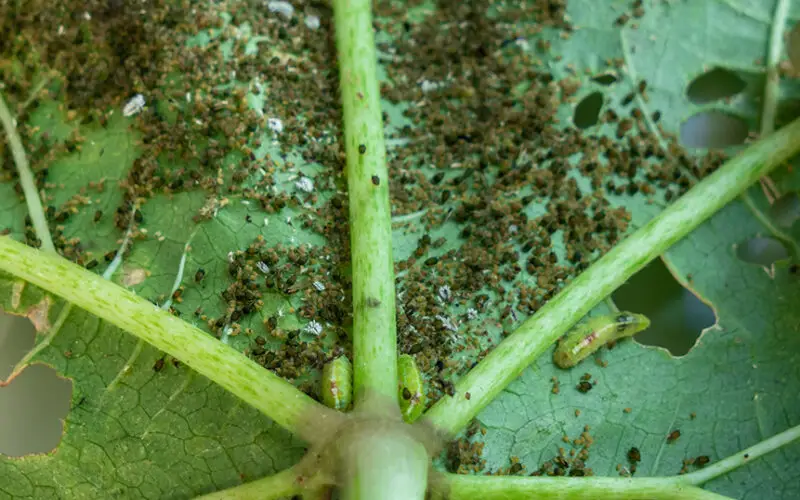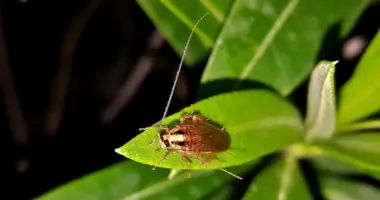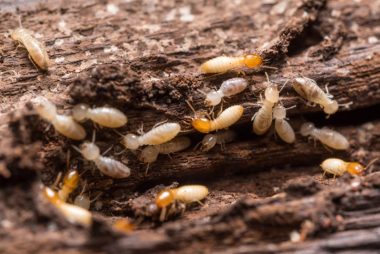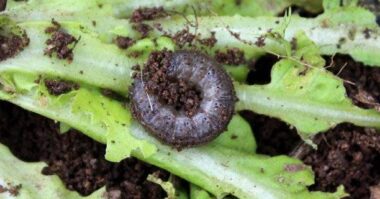The best fight against thrips is prevention, because it is difficult to get rid of them. To do this, simply keep the plants moist. Thrips do not develop when humidity is too high. Spraying water on outdoor and indoor plants will reduce the possibility of an invasion. Keep an eye on the humidity level so that your plants are not susceptible to cryptogamic diseases.
Unless a particularly virulent attack occurs, it is rare for the plant to die, however, thrips can weaken it and transmit viral diseases, such as tomato tan disease (which can affect many plants).
Contents
Plants affected by thrips attacks
Many plants are affected by thrips attacks: houseplants, flowering plants, trees and shrubs in the ornamental garden, berries (raspberry) and fruit trees, and, in the vegetable garden, tomato, cucumber, green bean, onion, leek, eggplant.
Each species of thrips often has a predilection for a given plant. In France, for example, we can find onion thrips, pea thrips, peach thrips, rose thrips, cereal thrips (or “storm beast”), olive thrips, gladiolus thrips… The Californian thrips, introduced in Europe at the end of the 80s, is particularly feared because of its virulence and the numerous plants it can parasitize.
3 plants that repel thrips
Garlic
You can plant garlic if the tomato plants are the target of the attack. Usually this is enough to make the thrips flee. We recommend to plant 1 foot for 270 square feet.
Oregano
Very useful in the kitchen, oregano acts as a repellent for mosquitoes, cabbage butterflies and cucumber beetles.
Other herbs that can help repel insects are parsley, dill, bay leaves, fennel or lemon balm.
Basil
In addition to scenting cooked dishes, basil is very useful in gardens, as it helps to scare away flies and mosquitoes. You can also install basil-filled planters near doors and windows to block insects before they enter the house.
How do you get rid of thrips naturally?
- Plant pyrethrins, derived from the flowers of certain Asteraceae, are authorized in organic farming. Acting by contact, they paralyze the nervous system of insects.
- Sweet orange essential oil: it is the terpenes it contains that destroy the cuticle protecting the soft tissues of the body from insects.
- The spinosad comes from a bacterium, Saccharopolyspora spinosa. It is authorized in organic agriculture since 2008, but it is also toxic to pollinators and some other beneficials, so use with caution.
- Diatomaceous earth: Diatomaceous earth is an alga whose external skeleton is composed of silica. Reduced to a very fine powder, it is used against many harmful insects. It acts by contact, by its capacity of absorption of water and lipids of insects.
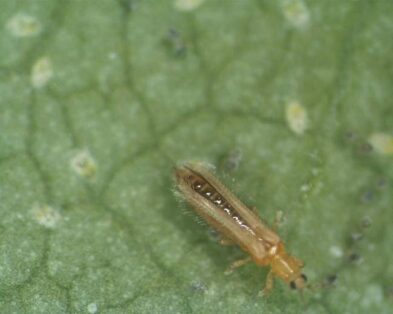
Will dish soap kill thrips?
Natural black soap is made from vegetable oil, usually olive or linseed, and potash (potassium hydroxide). It has multiple uses, especially in the garden because it is totally biodegradable.
- Make a 5% dilution of liquid black soap in water (4 to 5 tablespoons in a liter of water). Use lukewarm water for a homogeneous mixture and let it cool. Be careful with the composition of the black soap, it must not contain any additives or colorants.
- Some gardeners use a homemade solution: they mix a garlic-based decoction with black soap and water or add rapeseed oil to the dilution.
How to apply the black soap treatment against thrips?
Spray your invaded plants in quantity, without forgetting the back of the leaves. Preferably act in the evening when it is cooler, less than 68° F. A large part of the insects will be chased away by the water and the remaining ones will be killed because the soap blocks their respiratory system. Sprays can be repeated until the pest is gone.
Symptoms of a thrips attack
Plants affected by thrips are mottled with gray. The young shoots are deformed during their growth and become necrotic. Then the leaves eventually wither. The plant does not usually die, but once infected, it is then more susceptible to catch passing diseases such as tomato tan.
How to prevent new attacks?
- Thirsty plants are more sensitive to these aggressions. Water your plants according to their needs. Moreover these harmful do not like moisture, take advantage of it to vaporize all those of your plants which do not fear the cryptogamic diseases.
- Sow green manures such as clover or flax between your rotations. Not being among the plants appreciated by these harmful insects, these crops break their cycle.
- When plants are invaded, eliminate the insects before uprooting them so that they do not disperse, then destroy the plants.
- Change the substrate a few centimetres around plants that have been infested, to prevent the nymphs in the substrate from emerging as adults.
Summary
Despite their microscopic size, thrips are really harmful insects in the garden, especially in the vegetable garden where they can damage crops. Fortunately, although they are quite resistant, there are various methods, natural or not, bio or chemical, that can eliminate them.
Plant protection products are of course to be used only as a last resort, because they do not eliminate only the targeted pests. And as always in organic pest control, prevention is the key to success!
